Do Self-Driving Cars Use Artificial Intelligence?

The biggest question on your mind is: “Do self-driving cars use AI?” In the following paragraphs, we’ll explore the answer to that question and the challenges that it presents. The first hurdle is the massive amount of training required for AI networks to operate autonomous vehicles. To operate these vehicles, they must learn how to navigate and interpret data coming from sensors. As the technology continues to improve, it will likely be easier to build autonomous vehicles.
Self-driving cars use deep learning, a type of AI technology that works in a similar manner to the human brain. Data collected from self-driving cars is processed through a multi-layered neural network, which enables them to identify objects in milliseconds. This level of accuracy and complexity will enable self-driving cars to operate in congested cities. These cars will save time and money for companies running them, as they will no longer need a human driver to drive them.
To make this technology work, self-driving cars will have sophisticated computer vision algorithms that process sensor data and video. These systems will map the environment around the car and determine the best routes to take, the best speed to drive, and the most efficient maneuver. These systems will then feed that information into the self-driving car’s control stage. There are many other benefits to ADAS.
Although the concept of autonomous cars was ambitious, these vehicles are not yet common on roads. The advancement of AI related technologies has made them possible. Many of today’s self-driving cars have the ability to use full braking power during low-light conditions and even nighttime. Mercedes already has a night vision system, and can respond to voice commands and even weather alerts. If you’re wondering, “Do self-driving cars use Artificial Intelligence?” this article is for you.
Another breakthrough is LiDAR, which is used to detect objects in 360-degrees around the car. This technology is used to supplement cameras in low-light conditions. The radar’s sensors move the same way in low light. As a result, they are more accurate than cameras in low-light conditions. However, there’s still some debate over whether or not self-driving cars use AI.
The researchers at Cornell Ann S. Bowers College of Computing and Information Science, Cornell College of Engineering, and Google’s Brainlab are currently using deep learning and neural networks to develop an artificial intelligence system that can overcome this obstacle. By using memories of past experiences, the researchers hope to overcome this limitation. In a recent research paper, Yurong You, lead author, presented the research paper virtually at ICLR 2022, the International Conference on Learning Representations.
A further debate is whether self-driving cars need a license. As self-driving cars become the norm, countries may have to rethink license programs. Self-driving cars use artificial intelligence and are programmed to obey codes and laws, rather than human drivers. However, as they are not fully autonomous, they may not adapt to changing traffic conditions and may lead to crashes.







